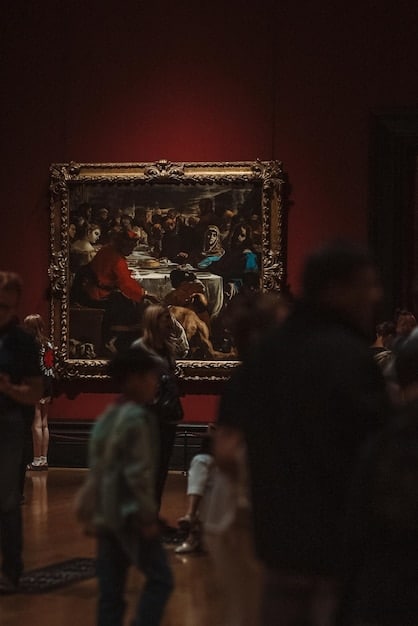Unveiling Subtext: 5 Secrets in Modern Theater Reviews

Unveiling the Unseen: 5 Insider Secrets to Understanding Subtext in Modern Theater Reviews explores the hidden layers of meaning in theatrical performances, offering insights into interpreting unspoken emotions, cultural contexts, and directorial choices that enrich the audience’s experience.
Theater reviews often scratch the surface, but true understanding lies beneath the dialogue. Unveiling the Unseen: 5 Insider Secrets to Understanding Subtext in Modern Theater Reviews will equip you with the tools to delve deeper and appreciate the artistry hidden within the unspoken.
What is Subtext and Why Does It Matter In Theater Reviews?
Subtext is the unspoken or implicit meaning in dialogue and action. It is what characters really mean or feel, even when they’re saying something else.
Understanding subtext elevates theater reviews from simple plot summaries to insightful analyses of the play’s emotional core. Here’s why mastering this skill is crucial:
Deeper Appreciation of Performances
Subtext reveals the actor’s skill in conveying complex emotions beyond the lines. Spotting it allows reviewers to appreciate nuanced performances.
Uncovering Hidden Themes
Subtext often hints at the play’s underlying themes, such as power dynamics or societal issues, enriching the overall critique.
More Accurate Interpretations
By grasping subtext, reviewers can provide more accurate and comprehensive interpretations of the playwright’s intent.
- Enhanced Engagement: Recognizing subtext keeps the audience engaged and thinking critically.
- More Profound Understanding: It unlocks a deeper layer of meaning, going beyond surface-level entertainment.
- Identifying Unspoken Emotions: Subtext helps discern the true feelings and motivations of characters.
- Comprehensive Review: It allows for reviews that are more insightful and complete, offering a more accurate portrayal of the play.
In essence, understanding subtext enables reviewers to uncover the true artistry of a theatrical performance, leading to more informed and engaging critiques.
Secret 1: Pay Close Attention to Body Language
Non-verbal cues can speak louder than words. Body language is a crucial component of subtext, revealing hidden emotions and intentions.
In theater reviews, analyzing these non-verbal aspects can significantly enhance the depth and insight of your critique:
Decoding Gestures and Posture
Are the actors fidgeting, avoiding eye contact, or standing rigidly? These can signal nervousness, deceit, or suppressed anger.
Facial Expressions as Indicators
A slight twitch, a fleeting smile, or a furrowed brow can reveal what words cannot. Pay attention to micro-expressions.
Movement and Spatial Relationships
How do characters move around each other? Do they maintain a distance or invade personal space? This can suggest power dynamics or emotional closeness.

Considering body language allows reviewers to provide a more nuanced and comprehensive assessment of a play’s emotional landscape, going beyond the literal dialogue to uncover the unspoken truths.
Secret 2: Analyze the Use of Silence and Pauses
Sometimes, what is not said is as important as what is said. Silence and pauses in dialogue create subtext, revealing unspoken thoughts and emotions.
Understanding the power of silence and pauses can transform a standard theater review into a compelling analysis of a play’s underlying tensions:
Intentional Pauses and Their Impact
A well-placed pause can indicate hesitation, contemplation, or a shift in power dynamics. Notice when and how actors use silence.
Unspoken Thoughts and Feelings
Silence can represent unspoken grief, secrets, or unresolved conflicts. It invites the audience to fill in the gaps, creating deeper engagement.
Building Tension and Suspense
Strategic use of silence can build tension, leaving the audience on edge and anticipating what will happen next. This should be noted.
By recognizing and interpreting these moments of silence, reviewers can provide a richer understanding of the play’s emotional and thematic undertones.
Secret 3: Identify Contradictions Between Words and Actions
Characters don’t always say what they mean. Inconsistencies between words and actions are rich sources of subtext, indicating internal conflict or deception.
In a theater review, highlighting these contradictions can reveal a character’s true state of mind and motivations:
Verbal vs. Non-Verbal Cues
Does a character say they’re fine while visibly trembling? This contradiction speaks volumes about their true emotional state.
Unfulfilled Promises and Broken Commitments
When characters fail to follow through on their words, it can reveal underlying dishonesty or weakness.
Hidden Agendas and Motivations
Contradictory behavior often points to hidden agendas and ulterior motives, adding layers of complexity to the character.
- Inconsistencies in dialogue: Are characters saying one thin but behaving in another way?
- Actions defying words: Do acts of kindness betray hateful sentiments? Are good wishes followed by cruelty?
- Examine motivations: Is the character’s behavior contradictory? If so, what could the real intention or motivation be?
Detecting and analyzing these contradictions adds depth to a theater review, offering a more nuanced understanding of the character’s psychological landscape.
Secret 4: Recognize Cultural and Historical Context
Subtext is deeply rooted in cultural and historical norms. Understanding a play’s context unlocks hidden layers of meaning and resonance.
Appreciating cultural and historical context empowers reviewers to offer insightful interpretations that resonate more profoundly with audiences:
Social Conventions and Expectations
How do societal norms of the play’s setting influence the way characters interact and express themselves? This is vital to understand.
Historical Events and Their Impact
Historical events, such as wars or social movements, often shape the subtext of a play, informing themes and character motivations.
Cultural Symbols and Metaphors
Cultural symbols and metaphors can carry significant weight, adding depth and nuance to the play’s subtext.

Recognizing these contextual elements allows reviewers to provide richer, more informed analyses that elevate the audience’s understanding and appreciation of the play.
Secret 5: Consider the Director’s Choices
A director’s vision shapes the subtext of a play. Paying attention to directorial choices reveals how the unspoken is emphasized and interpreted.
By deciphering the director’s artistic choices, reviewers can offer a comprehensive critique that acknowledges the layers of meaning beyond the surface:
Staging and Set Design
How does the staging emphasize certain relationships or themes? The set design can also hint as the play’s hidden layers.
Use of Lighting and Sound
Lighting and sound effects can underscore emotional moments and highlight unspoken tensions, adding depth to the subtext.
Pacing and Rhythm
The tempo of the play, from rapid-fire dialogue to deliberate pauses, can influence the audience’s perception of the subtext.
- Lighting: Does the lighting enhance some parts of the play to shine light on the subtext? What emotions are being conveyed?
- Sound: Is there a particular sound to certain acts or scenes that indicate a deeper meaning? Why are these included at this point in the play?
- Pacing: Is the pace matching tension or emotion? Are periods of high-tension quickly paced?
Evaluating the director’s role in shaping the subtext enhances the reviewer’s ability to provide a well-rounded and insightful critique.
| Key Element | Brief Description |
|---|---|
| 🎭 Body Language | Reveals hidden emotions through gestures and posture. |
| 🤫 Silence & Pauses | Highlights unspoken thoughts and builds tension. |
| 🎭 Contradictions | Identifies disparities between words and actions. |
| 🌍 Context Matters | Unlocks deeper meaning through cultural and historical understanding. |
Frequently Asked Questions
▼
Pay close attention to body language, silences, contradictions between words and actions, cultural context, and directorial choices. These elements often reveal unspoken emotions and hidden meanings.
▼
Cultural context provides a framework for understanding social norms, historical events, and cultural symbols that shape the subtext of a play. It adds depth and nuance to the interpretation.
▼
Director’s choices in staging, lighting, sound, and pacing can emphasize or create subtext. Analyzing these elements enhances your ability to spot the subtle cues and hidden meanings.
▼
Yes, absolutely. Silence can convey unspoken thoughts, emotions, and tensions, inviting the audience to fill in the gaps and engage more deeply with the story.
▼
Identifying these contradictions reveals hidden agendas, internal conflicts, and true motivations, allowing you to provide more nuanced and insightful critiques of character psychology.
Conclusion
By mastering these insider secrets, theater reviewers can transcend surface-level observations and deliver insightful analyses that capture the true essence of a performance. Understanding subtext enables reviewers to provide a more comprehensive and engaging critique, ultimately enriching the audience’s appreciation of the theatrical arts.





